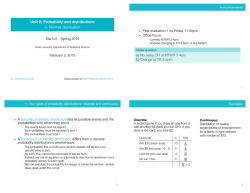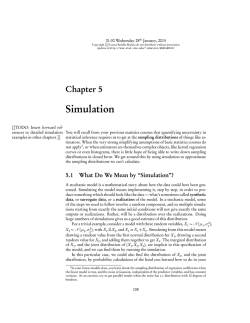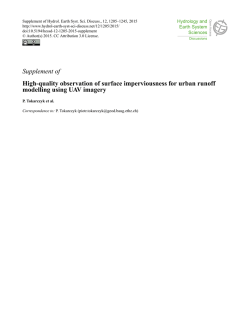
Recovering Copulae from Conditional Quantiles - Hu
Recovering Copulae from Conditional Quantiles
Wolfgang K. Härdle
Chen Huang
Alexander Ristig
Ladislaus von Bortkiewicz Chair of Statistics
C.A.S.E. Center for Applied Statistics
and Economics
HumboldtUniversität zu Berlin
http://lvb.wiwi.hu-berlin.de
http://www.case.hu-berlin.de
http://irtg1792.hu-berlin.de
Motivation
1-1
Copulae-Based Regression
Semiparametric regression based on parametric copulae.
I Curse of dimensionality can be mitigated. Noh et al. (2013)
I Misspecication problem?
Nonlinear quantile regression based on parametric copulae.
I Chen et al. (2009) and Bouyé and Salmon (2009)
I High-dimensional framework?
Recovering Copulae from Conditional Quantiles
Motivation
Comments by Dette et al. (2014)
One-dimensional quadratic regression model
Semiparametric estimation using parametric copulae family
Figure 1: What if the parametric copulae are misspecied?
Recovering Copulae from Conditional Quantiles
1-2
Motivation
1-3
Regression-Based Copulae
Recover copulae from regression machine.
I Copulae cannot but regression can cover basic relations.
I Most of the dependence is linear.
No assumptions concerning moments and distributions.
Real world applications require high-dimensional copulae.
I Penalized quantile regression (using LASSO to select
variables).
Recovering Copulae from Conditional Quantiles
Outline
1. Motivation
X
2. Conditional Quantile and Copulae
3. Estimation Procedure
4. Sampling and Simulation
5. Further Research
Conditional Quantile and Copulae
2-1
Conditional and Unconditional Copulae
def
Let uj = Fj (xj ), the conditional copulae are dened by
∆(u2 ) = CU2 |U1 =u1 (u2 )
(1)
From conditional copulae to unconditional copulae
C (u1 , u2 ) = F1 (x1 )CU2 |U1 =u1 (u2 ) = u1 ∆(u2 )
Recovering Copulae from Conditional Quantiles
(2)
Conditional Quantile and Copulae
2-2
Conditional Quantile and Copulae
The τ -th conditional quantile function of X2 given X1 = x1 ,
τ ∈ (0, 1], is
Q (τ |x1 ) = inf {x2 : F (x2 |X1 = x1 ) ≥ τ }
(3)
Inverting ∆(u2 ) = τ gives equivalence with (3)
F2−1 {∆−1 (τ )} = Q (τ |x1 )
Recovering Copulae from Conditional Quantiles
(4)
Conditional Quantile and Copulae
2-3
Conditional Quantile and Copulae
Start from a linear additive quantile regression model
ˆ (τ |x1 ) = α
ˆ )x1
Q
ˆ (τ ) + β(τ
(5)
ˆ (τ |x1 )} = τ ; otherwise,
If the specication is correct, F2|1 {Q
min
F2−|11 (·)
X
ˆ (τ |x1 )}2
{F2−|11 (τ ) − Q
(6)
τ
Estimate the monotonically increasing conditional quantile
function F2−|11 (·) by PAV (Pool-Adjacent-Violators) algorithm
PAV
PAVAlgo
Recovering Copulae from Conditional Quantiles
Conditional Quantile and Copulae
2-4
Moving to Higher Dimensions
For random vector (X1 , . . . , Xd ) ∈
∆(uk ) = CU
k
Rd , (1) becomes
|∀`6=k :U` =u` (uk )
(7)
Note: conditional copulae are the ratio of its partial derivatives.
More details
Similarly, taking inverse yields
Fk−1 {∆−1 (τ )} = Q (τ |∀` 6= k {X` = x` })
Recovering Copulae from Conditional Quantiles
(8)
Estimation Procedure
3-1
Estimation Procedure
Fit values from quantile regression.
Estimate the quantile curve from isotonic regression (PAV).
Take inverse to obtain the conditional copulae.
Repeat and multiply all conditional copulae to get
unconditional copulae (the order is not unique).
C (u1 , . . . , ud ) = F1 (x1 )
d
Y
i =2
Recovering Copulae from Conditional Quantiles
CU |∀j 6=i :U =u (ui )
i
j
j
(9)
Estimation Procedure
3-2
Stepwise Recursion
Figure 2: Stepwise recursion plot
Recovering Copulae from Conditional Quantiles
Sampling and Simulation
4-1
Random Sampling
Taking two-dimensional as example,
Generate iid v1 , v2 ∼ U [0, 1]
Generate x1∗ as the v1 -th quantile from the marginal
distribution x1∗ = F1−1 (v1 )
Generate x2∗ as the v2 -th quantile from the conditional quantile
function x2∗ = Q (v2 |x1∗ ) or x2∗ = F2−1 {CU−21|U1 =v1 (v2 )}
Then (x1∗ , x2∗ ) are sampled from the joint distribution F (x1 , x2 ).
Wei (2008).
Recovering Copulae from Conditional Quantiles
Sampling and Simulation
4-2
Estimated Conditional Quantile Curves
Sample from a bivariate normal copula with ρ = 0.5 and t10
distributed margins (sample size n = 1000)
By PAV algorithm, the conditional quantile function is
estimated as an interpolated step function
Figure 3: Estimated conditional quantile curves and cdf for dierent x1
Recovering Copulae from Conditional Quantiles
Sampling and Simulation
4-3
Estimated Bivariate Joint Copula
Sample from a bivariate Clayton copula with θ = 1.5
Figure 4: Estimated bivariate joint copula from Clayton copula sample
Recovering Copulae from Conditional Quantiles
Sampling and Simulation
4-4
Estimated Bivariate Marginal Copulae
1 0.1 0.5
Sample from a 3-dimensional t -copula with ρ = 0.1 1 0.9
0.5 0.9 1
Figure 5: Estimated bivariate marginal copulae from 3-dimensional t -copula
sample
Recovering Copulae from Conditional Quantiles
Further Research
5-1
Further Research
Which order in conditional decomposition?
Can we derive tail-dependence coecients?
Applications in asset portfolio risk measurements or network
spill-over eect analysis.
Recovering Copulae from Conditional Quantiles
Recovering Copulae from Conditional Quantiles
Wolfgang K. Härdle
Chen Huang
Alexander Ristig
Ladislaus von Bortkiewicz Chair of Statistics
C.A.S.E. Center for Applied Statistics
and Economics
HumboldtUniversität zu Berlin
http://lvb.wiwi.hu-berlin.de
http://www.case.hu-berlin.de
http://irtg1792.hu-berlin.de
References
6-1
References
Bouyé, E. and Salmon, M. (2009)
Dynamic Copula Quantile Regressions and Tail Area Dynamic
Dependence in Forex Markets
The European Journal of Finance, 15(7-8), 721-750
Chen, X., Koenker R. and Xiao, Z. (2009)
Copula-based Nonlinear Quantile Autoregression
The Econometrics Journal, 12(s1), S50-S67
Dette, H., Hecke R. and Volgushev, S. (2014)
Some Comments on Copula-Based Regression
Journal of the American Statistical Association, 109(507),
1319-1324
Recovering Copulae from Conditional Quantiles
References
References
Härdle, W. and Okhrin O. (2010)
De copulis non est disputandum - Copulae: An Overview
AStA Advances in Statistical Analysis, 94(1), 1-31
Noh, H., El Ghouch, A. and Bouezmarni, T. (2013)
Copula-Based Regression Estimation and Inference
Journal of the American Statistical Association, 108(502),
676-688
Wei, Y. (2008)
An Approach to Multivariate Covariate-Dependent Quantile
Contours with Application to Bivariate Conditional Growth
Charts
Journal of the American Statistical Association, 103(481),
397-409
Recovering Copulae from Conditional Quantiles
6-2
Appendix
7-1
Pool-Adjacent-Violators Algorithm
Need for it arises from monotonic smoothing of bivariate data
An iterative tool for isotonic regression/monotone smoothing
Results in an interpolated step function
Recovering Copulae from Conditional Quantiles
Appendix
7-2
Monotonic smoothing on {(Xi , Yi )}ni=1 can be formalized as:
1. Sort {(Xi , Yi )}ni=1 by X into {(X(i ) , Y(i ) )}ni=1
P
ˆ (X(i ) )}ni=1 minimizing ni=1 {Y(i ) − m
ˆ (X(i ) )}2 subject
2. Find {m
to the monotonicity restriction
ˆ (X(1) ) ≤ m
ˆ (X(2) ) ≤ · · · ≤ m
ˆ (X(n) )
m
Recovering Copulae from Conditional Quantiles
Appendix
7-3
The PAV (from the left) can be formalized as follows:
Algorithm
Step 1:
Start with Y(1) , move to the right and stop if (Y(i ) , Y(i +1) )
violates the monotonicity constraint, i.e., Y(i ) > Y(i +1)
Pool Y(i ) and the adjacent Y(i +1) , by replacing them both by
Y(∗i ) = Y(∗i +1) = (Y(i ) + Y(i +1) )/2
Step 2:
If Y(i −1) > Y(∗i ) , pool {Y(i −1) , Y(i ) , Y(i +1) } into one average.
Continue to the left until Y(i −1) ≤ Y(∗i ) .
ˆ (X(i ) ).
Proceed to the right. The nal solutions are m
Return
Recovering Copulae from Conditional Quantiles
Appendix
7-4
Partial Derivatives and Conditional Copulae
def
Taking d = 3 as example, let C 2 (u1 , u2 ) = C (u1 , u2 , 1) and
2
def
c12 (u1 , u2 ) = ∂ C ∂(uu11,u2 ) , then P(U2 ≤ u2 , U1 = u1 ) can be written
as
C 2 (u1 + ∆u1 , u2 )
lim
= c12 (u1 , u2 )
∆u1 →0
∆u1
The conditional distribution ∆(u2 ) (given xed u1 ) is the ratio of
derivatives:
c 2 (u1 , u2 )
P(U2 ≤ u2 |U1 = u1 ) = 1 1
c1 (u1 )
Return
Recovering Copulae from Conditional Quantiles
© Copyright 2024


